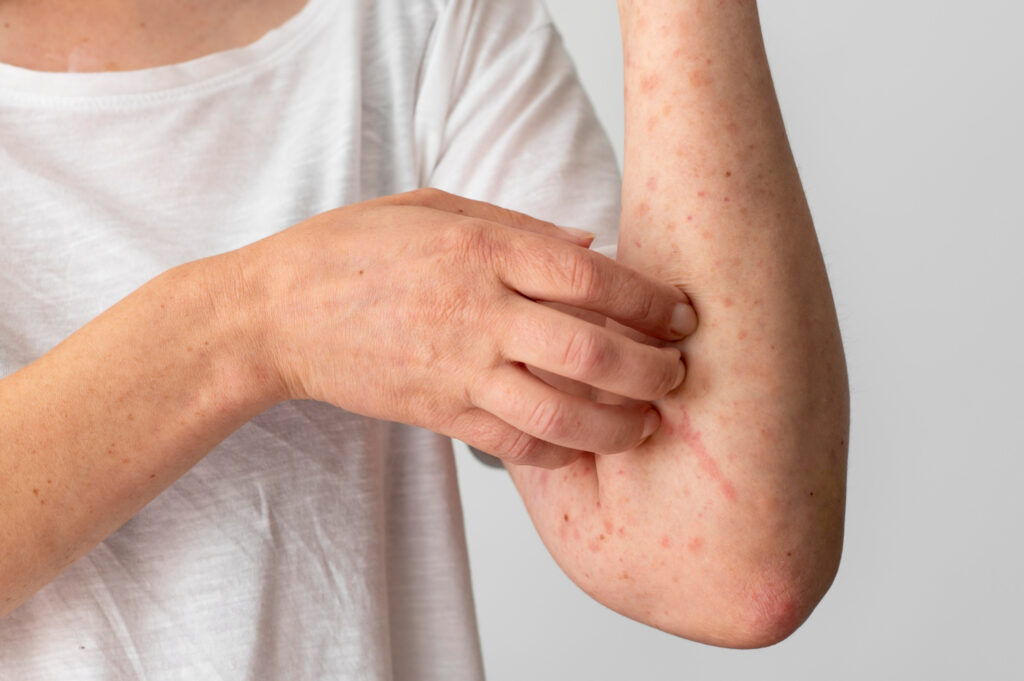people who are susceptible to the virus.
Infected individuals can spread the virus to others from the onset of prodromal symptoms up to 3 to 4 days after the rash appears. The virus can remain infectious in the air or on contaminated surfaces for up to 2 hours.

Infectious diseases are still a cause for concern. The degree of infectiousness of a given disease depends on the strength (virulence) of the bacteria or viruses and the body's immunity. We usually become infected during contact with a sick person. Pathogenic microorganisms are also spread by flies, mosquitoes, lice, and ticks.
It is often said that all children should be protected from bacterial infections, while viral infections can be provoked so that the child gets over the disease faster. According to the latest knowledge, provoking an infection is an irresponsible action, because it can end in serious complications, even death. You never know what the course of the infection will be, although it is usually milder than in older people up to the age of 14.
If someone has not had an infectious disease in childhood, they will be more seriously ill as an adult, and the infection can end in serious complications. This is because childhood diseases often have an atypical course in adults and it is difficult for doctors to recognize them. And when diagnosis and treatment are delayed, the risk of complications increases. However, complications are often the result of the adult organism not being adapted to fight childhood diseases.
Measles, mumps, and rubella are diseases that have similar symptoms. These diseases differ in their incubation period, contagiousness, and route of transmission.
The initial symptoms of measles, mumps, and rubella resemble the flu. Some people with mumps and rubella do not experience any symptoms. In the case of measles and rubella, a characteristic rash, or skin lesions, often appears on the skin. In the case of measles, we observe grey-white lumps, while in rubella, pink spots. Mumps is characterized by inflammation of the salivary glands.
There is a combined vaccine against measles, mumps, and rubella (so-called MMR). Two doses of the vaccine are taken, which provides maximum protection. According to the vaccination schedule, the first dose is administered at 13-15 months of age, and the second at 6 years of age. The effectiveness is high and lasts for the rest of your life. Adults are also advised to receive two doses of the vaccine if they were not vaccinated as children. The interval between doses should be at least 4 weeks.
Other diseases that may resemble measles in symptoms include:
Measles is caused by a virus from the paramyxovirus family, which is transmitted through droplets. It is an RNA virus that attacks the respiratory and immune systems. Although it is very contagious, it is sensitive to external conditions – it dies at a temperature of 56°C within 30 minutes and is susceptible to UV radiation.
Infection occurs through direct contact with an infected person, inhalation of droplets of secretions from the respiratory tract of an infected person, and contact with objects contaminated with secretions from the nose, throat, or blood of an infected person. Moreover, measles infection – like other infectious diseases – is often associated with immunodeficiencies, in which the body's protective functions are weakened.
It is usually not known about the virus infection before the first symptoms appear. These, in turn, are not always characteristic enough to make a diagnosis based on them.
The infection is transmitted by droplets, airborne droplets, or direct contact with the nasal and pharyngeal secretions or urine of an infected person. The virus is shed 1-3 days before the onset of fever and cough in an infected person, i.e., about 5 days before the rash appears and up to 3 days after it appears. If you have been infected, then after about 7-18 days you will develop a fever (on average 10 days) and a rash (about 14 days after infection). Measles does not cause you to be a carrier.
The disease develops in stages. The first symptoms appear 8-12 days after contact with the virus. The course of measles can be divided into several characteristic phases.
The prodromal period (3-4 days after infection with the measles virus) includes symptoms like:
During the eruptive period (4-7 days) you may experience:
In younger patients, measles often presents a more severe course than in adults. Infants who have not yet been vaccinated are particularly at risk because the level of maternal antibodies transferred during pregnancy gradually decreases during the first months of life.
In children, measles usually develops quickly, and its symptoms may be more severe. One of the first signs of the disease is a high fever, often exceeding 39–40°C, accompanied by an intense cough, runny nose, and conjunctivitis. A characteristic maculopapular rash appears a few days later, usually starting on the face and gradually spreading to the entire body.
Measles in children is also associated with a higher risk of complications.

Catching measles during pregnancy carries serious consequences for both the mother and the developing fetus. Measles, as a viral infectious disease, can lead to serious complications that affect the course of pregnancy, the woman's health, and the outcome of delivery.
Therefore, measles prevention among women planning a pregnancy is extremely important. Every woman should check her immunity status to measles by performing a serological test for the presence of antibodies against the measles virus. If the results show a lack of immunity, it is recommended to administer the MMR vaccine at least three months before the planned pregnancy. Vaccination during pregnancy is contraindicated due to the presence of live, weakened viruses in the vaccine.
Measles has a very severe course in states of impaired immunity. Patients with impaired cellular immunity, in whom measles often ends in death, are at risk of a particularly severe course. These include HIV-infected individuals, patients with congenital severe, combined immunodeficiencies, and all patients with malignant tumors undergoing chemotherapy or receiving other immunosuppressive therapy.
Patients in this group are particularly susceptible to developing acute encephalitis and progressive measles pneumonia. According to some reports, the mortality rate in the course of measles among cancer patients undergoing chemotherapy reaches 70%, and among HIV-infected patients 40%.
Diagnosing measles may be challenging in individuals with impaired cellular immunity because 25-40% of them do not have the characteristic measles rash. A severe course of measles should also be expected in debilitated individuals (e.g., with chronic cancer) and malnourished individuals (e.g., alcoholics and drug addicts).
A doctor may suspect measles based on an interview and physical examination. The diagnosis requires laboratory confirmation. In a person who has had contact with a person with laboratory-confirmed measles, a doctor may make the diagnosis based on characteristic symptoms.
The test material is blood. Specialists may do one of the tests:
The test material is a swab from the nasopharynx, throat, nose, and urine. The tests are designed to detect the genetic material of the virus.
The test material is a swab from the nasopharynx, throat, nose, urine, and blood collected in EDTA. The purpose of the test is to isolate the virus.
Molecular testing and virus isolation are not routinely used, they are useful for epidemiological purposes. The optimal period for sampling is 1-4 days after the onset of the rash.
There is no causal treatment for this disease, so treatment focuses on relieving symptoms and preventing complications that may occur due to measles. During therapy, the most important thing is to provide appropriate conditions for convalescence, including rest and isolation of the patient to prevent further spread of the disease.
Symptomatic therapy includes the use of antipyretics to reduce high body temperature and proper hydration, which is crucial in the case of fever and fluid loss. Depending on its course, it may be necessary to administer fluids orally or, in more severe cases, intravenously. It is also significant in relieving cough and sore throat, e.g., with home inhalation or protective syrups.
An essential treatment element is vitamin A supplementation, especially in children, because its deficiency can exacerbate the course of the disease and increase the risk of complications, such as damage to eyesight. In addition, the eyes should be protected from light, especially when symptoms are most severe.
Moreover, proper nutrition should not be overlooked. It should be easily digestible and rich in nutrients that support the immune system. Eat small, frequent meals that supply energy, protein, vitamins, and minerals. For children, foods should be easy to swallow and gentle on the throat.
Providing appropriate care during measles treatment can significantly alleviate symptoms and reduce the risk of complications.

Vaccination against measles is very effective. After the first dose of the vaccine, a vaccinated person gains 95% immunity, and the second dose allows the vaccinated person to achieve almost 100% immunity. People who have not been vaccinated and have not had measles should be vaccinated. Additionally, people vaccinated with only one dose of the vaccine should take the second dose.
In the period before universal vaccination against measles, i.e. before 1975, measles in the population was a common phenomenon. Therefore, people over 50 are very likely to have had measles. Moreover, having measles provides permanent immunity for life.
If you do not know or do not remember whether you have had the disease or been vaccinated, you should:
Adults vaccinated with one dose of the vaccine should receive a second, booster dose of the vaccine in order to be fully immunized. The cost of vaccinating a person over 19 years of age is the responsibility of that person.
Vaccination against measles may be carried out with a combined vaccine against measles, mumps, and rubella.
The vaccine administration schedule is indicated according to which it is recommended to administer 1 dose of the vaccine as a basic vaccination. It is recommended to administer a 2nd dose of the vaccine, preferably within 3 months of the 1st dose (not earlier than 4 weeks after the 1st dose).
It is not recommended to administer the vaccine during pregnancy, and pregnancy should not occur for 1 month after vaccination.
Complications after measles occur in an estimated 20% of patients. The most common include as following.
Respiratory complications are:
Neurological complications include:
Moreover, sensory organ complications may be:
In addition, measles sometimes causes complications such as myocarditis or hepatitis.
Table of Contents